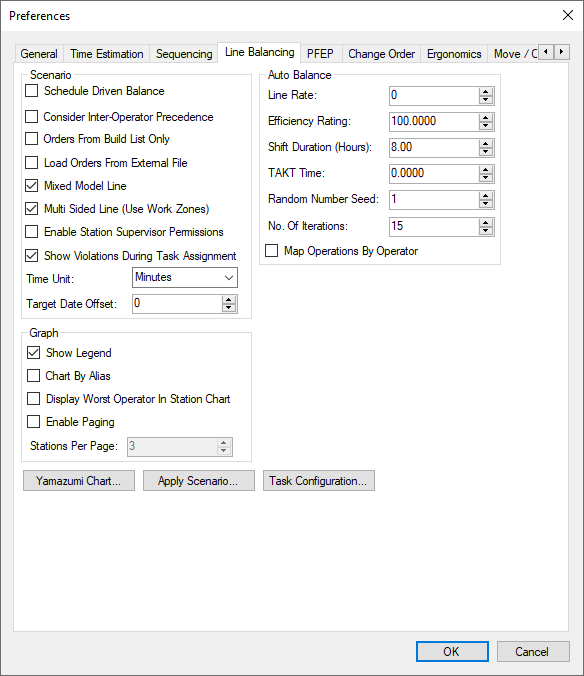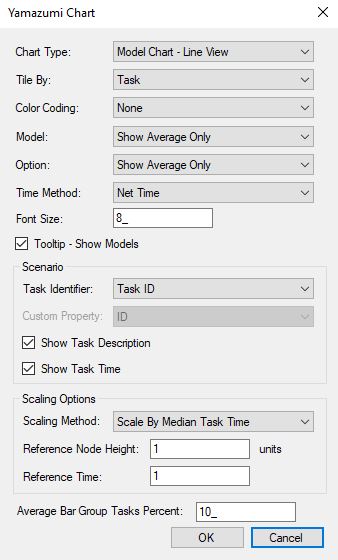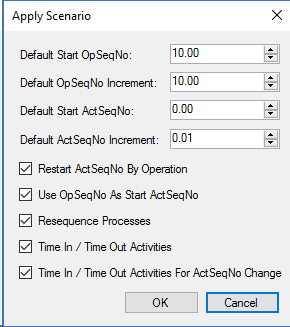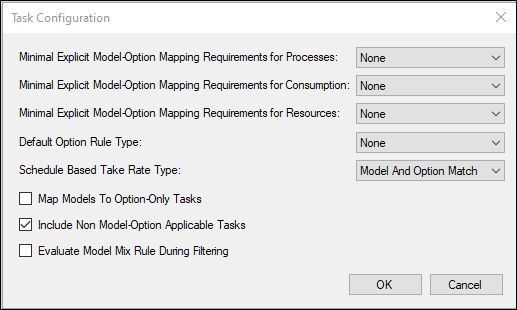The following screen is used to set up the default values to be used in the Line Balancing module. The values set here are defaults and can be altered during the creation of the balance.

Preferences-Line Balancing Tab
Scenario
Schedule Driven Balance: Sets the default for Enabling a Schedule Driven Balance, this is selectable also when creating a scenario, not using a Schedule Driven Balance will allow the take rates to be set for each model-option included in the scenario
Consider Inter-Operator Precedence: Sets the default for this Option when performing an Auto Balance
Orders From Build List Only: Sets the default for selecting orders from the build list only, each scenario can consider all orders by having this unchecked, or build list (scheduled) orders only when checking this option
Load Orders From External File: Sets the default for sourcing the Orders in a Schedule Driven Balance, this allows users to manually load a prepared file of order information, versus using system orders
Mixed Model Line: Sets the default for selecting a mixed model line or single model line
Multi Sided Line: Sets the default for selecting a multi-sided line (which allows for work zones)
Enable Station Supervisor Permissions: If set to True, the Permissions button in the Line Balancing Scenario Manager can be used to manage who can edit each scenario file. By default, only administrators and users defined as the Line Supervisor for a station in the Plant Editor can create or edit scenarios files containing those stations. If set to False, the Permissions control will have no functionality.
Show Violations During Task Assignment: Determines if violations should be automatically previewed when moving tasks, if set to False, any violations resulting from moving tasks will not be previewed
Time Unit: Sets the default time unit displayed in the scenario (available time units include MicroSeconds, Seconds, Minutes, Hours, Days, TMUs, MUs, MOD, TWTMIN) the Time Unit may be adjusted when created a scenario
Target Date Offset: Sets default number of days (integer) to offset from the determined Target Date
Auto Balance
Line Rate: sets the default for the number of units produced per shift
Efficiency Rating: sets the default for the operator efficiency as a percentage, this can exceed 100.00 but typically will be less than 100.00%
Shift Duration: sets the default length of each shift in hours, use decimals to set shift duration between whole numbers (7.5 hours = 7 hours, 30 minutes)
TAKT Time: sets the default desired Takt time, Takt time will be represented as the Time Unit determined in the previous preference setting, the Takt Time will be displayed in the Line Balance chart as a red line to assist with manual balancing and will also be used to run the Auto Balance feature
Random Number Seed: sets the default for the seed used during the line balance
No. of Iterations: sets the default for the number of iterations the algorithm will run to obtain a solution. Note: More iterations can create more accuracy but can take more time to run, this applies to the Auto Balance feature only
Map Operations By Operator: Used by the Apply Scenario routine. If set to True, an operation will be created for every operator (all activities in an operation will be mapped to one operator). If set to False, activities in an operation could be mapped to multiple operators.
Graph
Show Legend: changes whether the line balancing graph legend is displayed automatically. If the box is checked, the legend will automatically appear when you create a balance. If the box is unchecked, the legend will be hidden unless turned on using the graph's menu.
Chart By Alias: sets default for displaying the chart bars as a representation of Alias, or Models if left unchecked
Display Worst Operator in Station Chart when checked, the bar for the operator with the most work time will be shown in the station chart instead of the average time bar.
Enable Paging: Determines if the scenario should automatically enable paging, user will have the ability to adjust paging as needed within the scenario, paging enhances the visibility of the chart, depending on the number of models per station and station-operators per scenario
Stations Per Page: If paging is enabled, determines the default number of stations to display per page, this can be adjusted within the scenario

Yamazumi Chart Details
Chart Type: Model – Line View: Displays the work content assigned to each station for each model.
Model – Operator View: Displays the work content assigned to each operator for each model.
Option – Line View: Displays the work content, by station, required for each option.
Option – Operator View: Displays the work content, by operator, required for each option.
Tile by: User can choose here if the want to tile it by Task or Group.
Color coding : Gives you the option to color each task in the chart by default or to display VA/NVA/SVA (green/red/yellow) color coding to see the breakdown within the scenario.
None: Displays tasks without a coloring scheme
VA / NVA - Summary: Colors the tasks according to the majority of VA/NVA/SVA classification for each task.
VA / NVA - Task Sorted: Colors the tasks according to the VA/NVA/SVA classifications within each task.
VA / NVA - Time Category: Sorts and colors the VA/NVA/SVA classifications within the station, separating tasks with multiple classifications into multiple tiles before sorting.
Model: Gives you the ability to choose from which models to display tasks.
Option: Allows you to choose from which option group to display tasks.
Time Method: If net time is selected, it will show all of the work content of the models for that station or operator. The average time will also be displayed with this. If you use weighted time, it only displays the average time for the given station or operator.
Font Size: The user can modify the font size through this.
Task Identifier: Display either Task ID or Task Sequence Number on the task tiles.
Scaling Method: Change the size of each task tile and scale of the chart as a whole by Chart Bounds, by Median Task Time, by Minimum Task Time, or by User Input (define height in pixels or reference time).
Reference Node Height: Reference Height to use if Scaling Method is set to Scale By User Input
Reference Time: Reference Time to use if Scaling Method is set to Scale By User Input
Average Bar Group Tasks Percent: This allows the user to group smaller tasks into one task for better visibility of the chart view. The user is able to set the value which determines what tasks will be grouped together, it represents a percentage, tasks which represent less time than the value will be grouped, task that represent more time than the value will be shown as a single tile

Apply Scenario Settings
Default Start OpSeqNo: OpSeqNo to start numbering
Default OpSeqNo Increment: Increment for OpSeqNo
Default Start ActSeqNo: ActSeqNo to start numbering
Default ActSeqNo Increment: Increment for ActSeqNo
Restart ActSeqNo By Operation: Act Seq No values will restart for each operation. Otherwise the numbering and increment will start from the first activity in the routing and keep counting up until the last.
Use OpSeqNo As Start ActSeqNo: Activities under an operation will use the OpSeqNo of the operation as the starting point for ActSeqNo values and increment from there. For example, if OpSeqNo is 20, ActSeqNo values could be 20.01, 20.02, etc. This only applies if ResequenceProcesses is true.
Re-sequence Processes: Re-sequence Processes will update Seq no values based on the user settings after an apply scenario. Even if it is not used, the ActSeqNo values are still changed via a default logic that exists.
Time-in & Time-out Activities: Determines if the Activities being moved across Work Stations should get new Effectivitiy Dates or should continue to have their existing ones. (For example, If an activity is currently at Station 1 with an Effective From Date of 6/15/2017 and and Effective To Date of 7/15/2017, the activity may be moved to Station 2 with a target date of 7/4/2017. If this preference is true, then the Station 1 instance will be timed out on 7/3/17 and the Station 2 instance will be timed in on 7/4/17 with a To Date of 7/15/17).
Time-in & Time-out Activities For ActSeqNo Change: Determines whether Activities should be Timed-in / Timed-out for ActSeqNo change during Apply Scenario (even though the Activity has stayed under the same Operation.)

Task Configuration Settings
Minimal Explicit Model Option Mapping Requirements for Processes:
Determines if activities without any models and/or options mapped to them should be included when filtering for a specific model / option configuration.
None: Task need not be explicitly mapped to any models or options. No check needed.
Model Or Options: Task has to be explicitly mapped to at least one model or at least one option.
Model And Options: Task has to be explicitly mapped to at least one model and at least one option.
Minimal Explicit Model Option Mapping Requirements for Consumption:
Determines if activity-consumption records without any models and/or options mapped to them should be included when filtering for specific model / option configuration.
None: Part need not be explicitly mapped to any models or options. No check needed.
Model Or Options: Part has to be explicitly mapped to at least one model or at least one option.
Model And Options: Part has to be explicitly mapped to at least one model and at least one option.
Minimal Explicit Model Option Mapping Requirements for Resources:
Determines if activity-resource records without any models and/or options mapped to them should be included when filtering for specific model / option configuration.
None: Resource need not be explicitly mapped to any models or options. No check needed.
Model Or Options: Resource has to be explicitly mapped to at least one model or at least one option.
Model And Options: Resource has to be explicitly mapped to at least one model and at least one option.
Default Option Rule Type: Determines whether Option Mapping (None) or Option groups logic should be used to filter tasks and calculate take rate type
Schedule Based Take Rate Type: Determines how take rates should be calculated and how activities should be filtered based on model-option mapping. Only applicable to order based filtering.
Map Models to Option-Only Tasks: Uses order to map models to tasks containing only option mapping
Include Non Model-Option Applicable Tasks: If set to True, this includes all activities in line balancing, even if they should be filtered out based on model and option filtering rules defined by other preferences. Tasks that would have otherwise been filtered out by model and option filtering are still brought into the scenario, but will be given a take rate of 0. *Effective Date filtering is not affected by this - those tasks that are filtered due to effective dates would still be excluded.
Evaluate Model Mix Rule During Filtering: Determines whether the model library option rules should be used to create subsets of options for each model when performing model-option filtering.